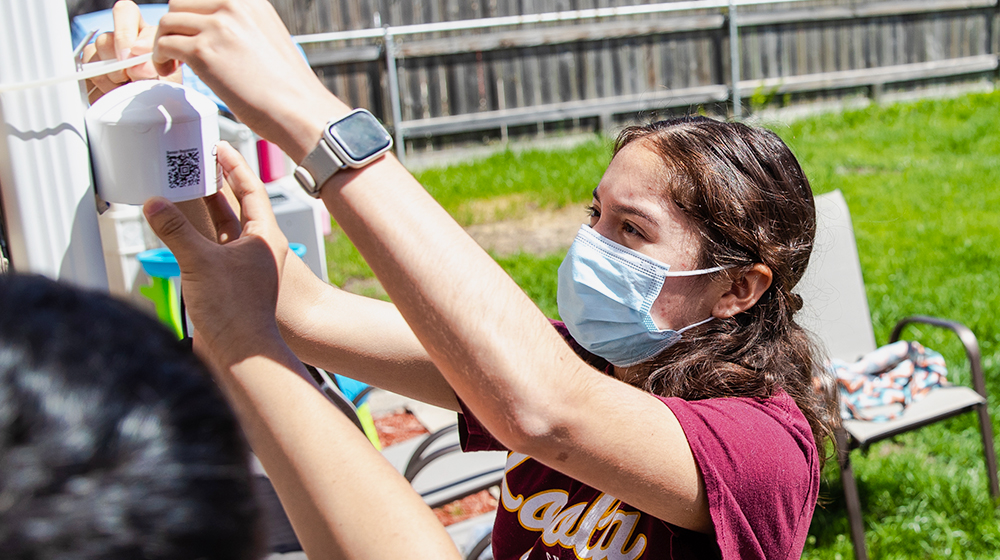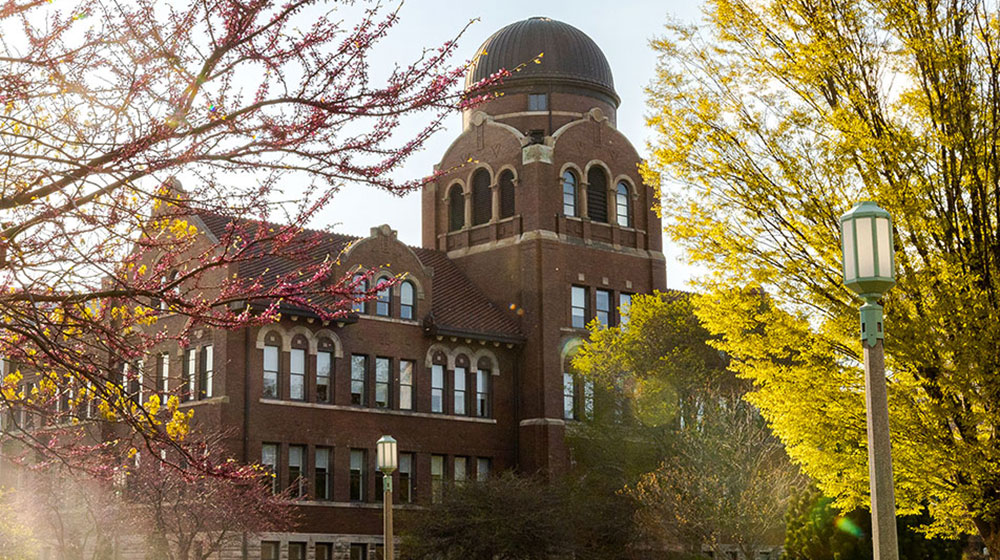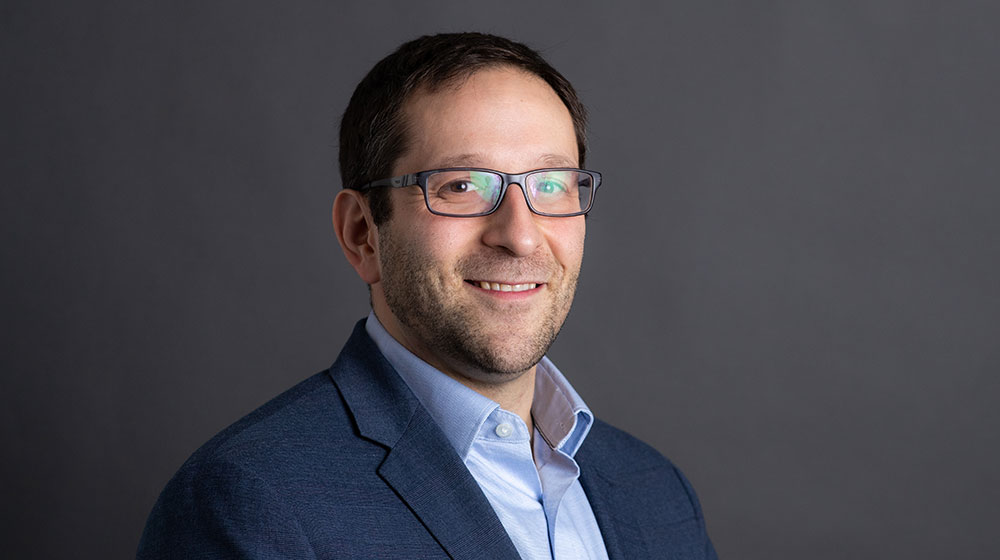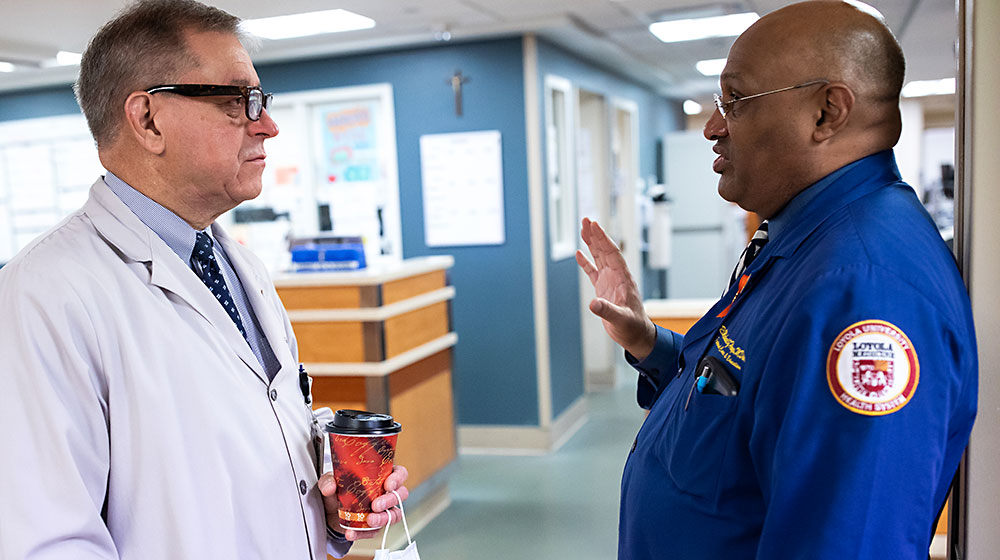Story - SES - Accessible Science

Students from the School of Environmental Sustainability install air quality monitors near the Hegewisch neighborhood on Chicago's South Side. The monitors connect to a nationwide network of monitors to help researchers collect air quality data and assess disparities across neighborhoods. PHOTO BY LUKAS KEAPPROTH
Loyola Students and Faculty Team Up to Assess Air Quality Disparities
The hands-on learning compares air quality in communities of color and white neighborhoods
Chicago has some of the nation’s most polluted air, according to the American Lung Association’s 2023 State of the Air report, but the toxins aren’t spread evenly throughout the city. Instead, the worst air quality is in neighborhoods where people of color live.
This disparity has real world affects. A report from the Chicago Department of Public Health found the air quality inequity contributes to Chicago’s nine-year life expectancy gap between Black and white residents and reduces life expectancy in the Latinx community.
Ping Jing, an associate professor at Loyola's School of Environmental Sustainability (SES), is working with a group of students and Tania Schusler, an assistant professor at SES, to measure air quality in two different neighborhoods. It’s an effort that combines Loyola’s commitment to applied research and experiential learning with its efforts to address environmental threats and health inequities.

Loyola University Chicago
The Pursuit of Purpose
What can be learned from Loyola’s 153-year track record on social impact
Read the story
Quinlan School of Business
Ethics in the Wild
Teaching students to remain responsible in the business world
Read the Story
Parkinson School of Health Sciences and Public Health
Forged In Crisis
Validating a collaborative approach to improving human health
Read the storyLearning the Scientific Process
Jing and Schusler's new project, a collaboration with Colorado State University, is named the Community Air Research Experience (CARE), and it marries her scientific scholarship around pollution with her desire to contribute to community health equity. Funded by a three-year National Science Foundation grant, CARE offers undergraduate students from groups traditionally underrepresented in the sciences opportunities to participate in all aspects of the scientific process.
This past spring, a cohort recruited through Loyola student organizations that serve students of color participated in seminars and field trips to learn the nuts and bolts of research design. As paid interns over the summer, they spent four weeks installing air monitoring instruments, learning computer programming skills, and collecting data. In the fall, they finalized and disseminated their findings.
Their goal was to better understand Chicago’s uneven distribution of particulate pollution while also generating more data that could be used by researchers considering possible solutions to the problem. Particulate matter is a mixture of solids, such as dust or soot, with liquid droplets in the air. It can easily seep into the respiratory tract or bloodstream, exacerbating ailments like asthma and heart disease. Even mild exposure can induce coughing, sneezing, or shortness of breath. CARE is focused on measuring particles less than 2.5 micrometers in diameter, also known as fine particles or PM2.5, which pose the greatest risk to health.
Research indicates air pollution is heavier in communities populated by people of color. A 2022 assessment published in the Environmental Science and Technology Letters found neighborhoods redlined by federal officials in the 1930s, including some in Chicago, still carry higher levels of air pollution eight decades later. Closer to home, a local ABC affiliate analysis of EPA data found 44 percent of Latinx people in the Chicagoland area live in areas considered a high risk for respiratory illness, compared to just 21 percent for white people.
Benefits the Public
CARE joined forces with two Chicagoland environmental organizations: the Southeast Environmental Task Force, in the southeastern neighborhood of Hegewisch, and Edgewater Environmental Coalition, headquartered near Loyola’s Lake Shore Campus. The neighborhoods were selected strategically—Edgewater, nestled along Lake Michigan, is relatively affluent and walkable compared to Hegewisch, known for its tangle of roadways and its manufacturing base.
From there, the students installed air quality sensors at four sites in the two neighborhoods. The PurpleAir machine used at Centro Romero, a community-based organization that serves refugees and immigrants in Edgewater, is a small white bulb that can fit in the palm of an adult’s hand. The students attached it to a doorway alongside a bus-laden stretch of Clark Street.
Loyola junior Ethan Bower has a working hypothesis that air quality, over time, has diverged between neighborhoods on the North and South Sides. He was so taken by the installation process that he’s planning to purchase a sensor for his own house. His classmate Mereya Riopedre is focusing on the correlation between neighborhood walkability and PM2.5 concentration.
Standing on Clark Street, watching traffic cruise by, Riopedre admits how excited she is to collaborate with some of Chicago’s most storied environmental justice organizations. The data her sensor collects will provide more evidence that change is needed.
“It’s accessible science,” she says. “I feel like if you’re doing science, and you can’t explain how it benefits the public, you should probably rethink your approach.”
Learning the Scientific Process
Jing and Schusler's new project, a collaboration with Colorado State University, is named the Community Air Research Experience (CARE), and it marries her scientific scholarship around pollution with her desire to contribute to community health equity. Funded by a three-year National Science Foundation grant, CARE offers undergraduate students from groups traditionally underrepresented in the sciences opportunities to participate in all aspects of the scientific process.
This past spring, a cohort recruited through Loyola student organizations that serve students of color participated in seminars and field trips to learn the nuts and bolts of research design. As paid interns over the summer, they spent four weeks installing air monitoring instruments, learning computer programming skills, and collecting data. In the fall, they finalized and disseminated their findings.
Their goal was to better understand Chicago’s uneven distribution of particulate pollution while also generating more data that could be used by researchers considering possible solutions to the problem. Particulate matter is a mixture of solids, such as dust or soot, with liquid droplets in the air. It can easily seep into the respiratory tract or bloodstream, exacerbating ailments like asthma and heart disease. Even mild exposure can induce coughing, sneezing, or shortness of breath. CARE is focused on measuring particles less than 2.5 micrometers in diameter, also known as fine particles or PM2.5, which pose the greatest risk to health.
Research indicates air pollution is heavier in communities populated by people of color. A 2022 assessment published in the Environmental Science and Technology Letters found neighborhoods redlined by federal officials in the 1930s, including some in Chicago, still carry higher levels of air pollution eight decades later. Closer to home, a local ABC affiliate analysis of EPA data found 44 percent of Latinx people in the Chicagoland area live in areas considered a high risk for respiratory illness, compared to just 21 percent for white people.
Benefits the Public
CARE joined forces with two Chicagoland environmental organizations: the Southeast Environmental Task Force, in the southeastern neighborhood of Hegewisch, and Edgewater Environmental Coalition, headquartered near Loyola’s Lake Shore Campus. The neighborhoods were selected strategically—Edgewater, nestled along Lake Michigan, is relatively affluent and walkable compared to Hegewisch, known for its tangle of roadways and its manufacturing base.
From there, the students installed air quality sensors at four sites in the two neighborhoods. The PurpleAir machine used at Centro Romero, a community-based organization that serves refugees and immigrants in Edgewater, is a small white bulb that can fit in the palm of an adult’s hand. The students attached it to a doorway alongside a bus-laden stretch of Clark Street.
Loyola junior Ethan Bower has a working hypothesis that air quality, over time, has diverged between neighborhoods on the North and South Sides. He was so taken by the installation process that he’s planning to purchase a sensor for his own house. His classmate Mereya Riopedre is focusing on the correlation between neighborhood walkability and PM2.5 concentration.
Standing on Clark Street, watching traffic cruise by, Riopedre admits how excited she is to collaborate with some of Chicago’s most storied environmental justice organizations. The data her sensor collects will provide more evidence that change is needed.
“It’s accessible science,” she says. “I feel like if you’re doing science, and you can’t explain how it benefits the public, you should probably rethink your approach.”
